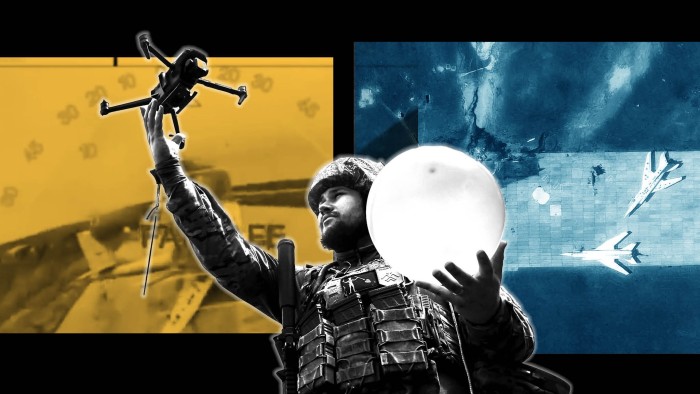The stunning footage of Russian military airfields obscured by thick plumes of smoke and strategic bombers going up in flames served to demonstrate Ukraine’s resolve and ability to strike targets as far as beyond the Arctic Circle.
Kyiv’s daring “Operation Spiderweb” carried out by Ukraine’s security service (SBU) earlier this month against four air bases in Russia also highlighted the devastating effects of a technological race being shaped by artificial intelligence.
“War is changing every day now,” said Valeriy Borovyk, chief executive of First Contact — the company that produced the small and agile quadcopters deployed against the Russian airfields. “Swarm drones, miniaturisation, ‘last-mile’ AI targeting . . . we need to prepare for all of this.”
Russia’s full-scale invasion of Ukraine has been shaped by rapid cycles of innovation and adaptation by both sides, including in autonomous systems and weapons to counter them.
If the cheap drones deployed on the battlefield are the equivalent of Soviet cars, Borovyk described his as the “Mercedes” of UAVs: advanced, fully customisable machines boasting AI and premium materials. Borovyk named his model the Osa, after a fictional, 17th-century Cossack and main character of a 2022 movie he produced.
“These are special drones for special missions, five times more expensive than normal drones,” Borovyk told the Financial Times.
Rather than the open frame typical of the first-person view drones used on the frontline, the UAVs used in Operation Spiderweb sport an enclosed frame allowing the machine to withstand bad weather and to hide anti-jamming technology.
According to the SBU, AI-powered autonomous systems allowed the drones to keep flying “along a pre-planned route” even after losing signal. “After approaching and contacting a specifically designated target, the warhead was automatically triggered,” the security service said.

Yaroslav Azhnyuk, another drone developer for the Ukrainian military, said that “both Ukraine and Russia are beginning to scale up their early stage autonomous capabilities”.
While fully autonomous targeting remains fraught with challenges, “terminal guidance” — where the drone pilot manually selects a target on the screen before letting AI take over — is already used on the battlefield, he said.

Azhnyuk’s The Fourth Law company delivered the first such AI systems to frontline units one year ago for trial runs, he said. Several other companies have been running similar experiments.
Ukraine’s digital transformation minister Mykhailo Fedorov last month announced the deployment of a drone carrier able to fly up to 300 kilometres and drop two FPV drones with autonomous navigation and targeting capabilities.
Russia is also stepping up its AI capabilities.
Ukraine’s military intelligence (HUR) on Monday said it identified a Russian drone equipped with systems for autonomous target search and selection. The drone also used US components from game consoles, according to the agency.
The evolution of drone warfare has been driven by changing tactics, dwindling resources and the need to operate in a battlefield saturated with equipment designed to jam wireless signals.
“War is a constant competition of adaptation between the two sides, and it’s not enough to just increase the quantities,” said Lyuba Shipovich, the co-founder of Dignitas Ukraine, a non-profit providing drones for the Ukrainian military as well as training for its pilots.
In recent months, the Ukrainian military supported by mil-tech companies and volunteer organisations have rushed to develop and deploy models of drones able to intercept Russian reconnaissance UAVs and, eventually, the long-range Shahed drones made in Russia with Iranian technology.
“It’s our main focus right now,” said Bohdan Danyliv, head of the military department of the Prytula Foundation, one of the largest Ukrainian civilian organisations crowdfunding for the military. The organisation said it had delivered almost 600 fixed-wing interceptors since the start of the year, which were used to shoot down 247 Russian reconnaissance and kamikaze drones.
“Why is Ukraine always finding new solutions? It’s always because we don’t have something. We didn’t have artillery shells, so we started using FPV drones. We don’t have enough . . . anti-air missiles — so we use interceptors,” Danyliv said.
Kicked off last summer, the race to intercept Russian reconnaissance drones flying increasingly deep within Ukraine began with the use of boosted FPV drones, since then largely replaced by more powerful and faster fixed-wing UAVs.
“But it is still not mass production, and there currently still isn’t a good technology to fight against drones like the Shaheds,” Shipovich said.

Ukraine is also lagging behind in the use of drones transmitting signals through a thin, translucid fibre optic cable.
The deceptively simple technology has reshaped the battlefield since Russian troops started using it to push back Ukrainian forces from Kursk region last year, allowing drone pilots to ignore jamming devices and hit any vehicle or soldier within range of their cable.
As Moscow accelerates its summer offensive, the advantage has helped the Russian military advance faster in May than it has at any point since last November.
“We made a mistake,” said Oleksandr Yakovenko, chief executive of TAF Drones, a firm among the largest drone producers in Ukraine.
“When our enemy started using fibre optic drones in the Kursk direction, we initially thought that it wouldn’t be very effective, that it wouldn’t be used massively.”
TAF Drones is trying to catch up, and has increased its fibre optics drone production — delivering as many as 10,000 a month. “But overall we would probably need to make up to 70,000 fibre optics drones with a range of 25km,” he said.
Illustration by Ian Bott, cartography by Steven Bernard
